King Neptune, Steel Beach Picnic Day, and Other Awesomely Strange US Navy Traditions
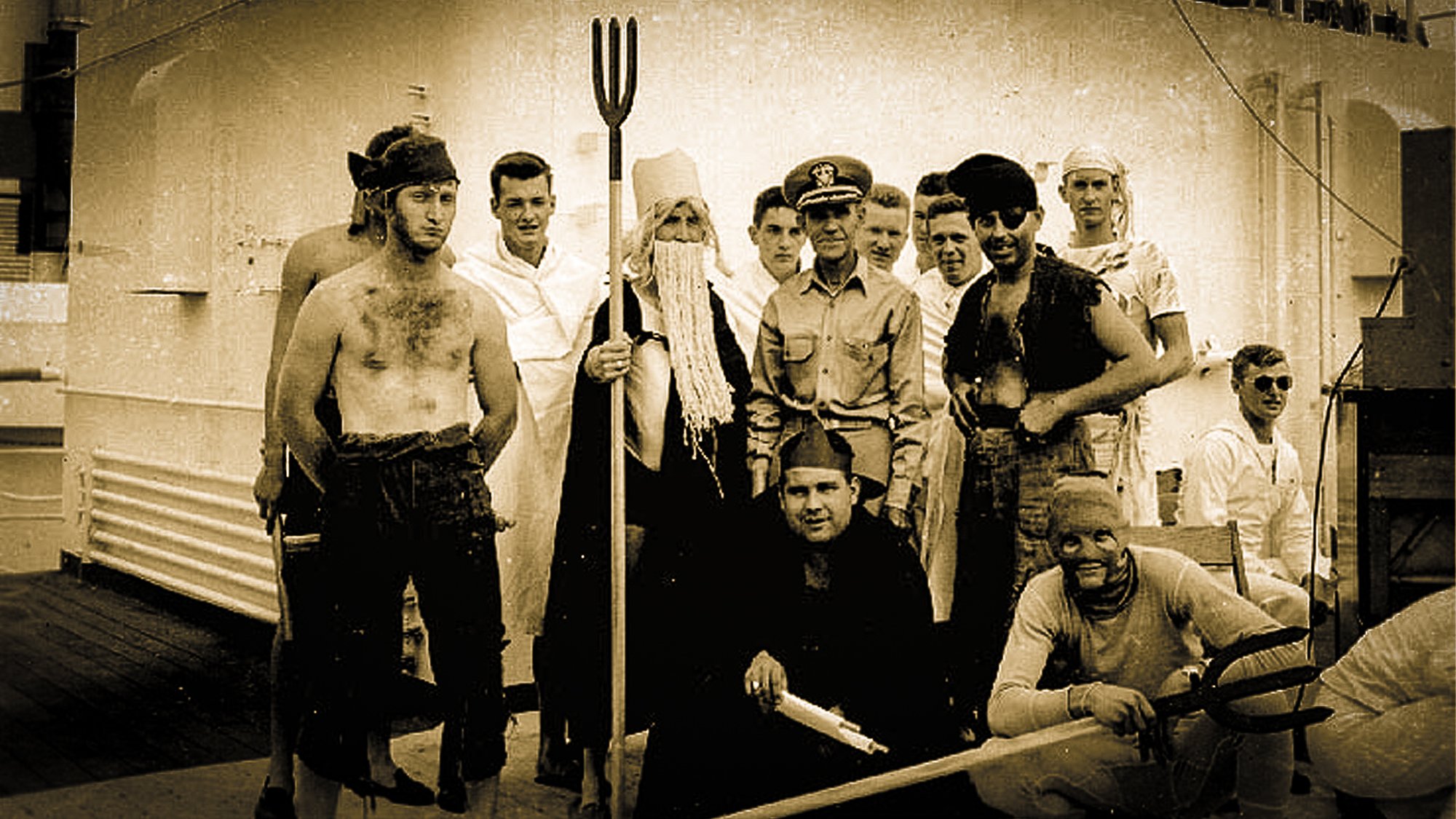
Commander William Van C. Brandt welcomes King Neptune, the King's Royal Court, and Davey Jones on board in mid-Pacific for the trial of Public Enemy Number One and a V-J Day celebration, Aug. 15, 1945. The King Neptune costume is typically worn during equator line-crossing ceremonies. Photo courtesy of the Naval History and Heritage Command.
On Oct. 13, 1775, the Continental Congress authorized the creation of the first American naval force, the predecessor of today’s United States Navy. In 1972, Chief of Naval Operations Adm. Elmo Zumwalt officially recognized Oct. 13 as the US Navy’s birthday and called for a Navy-wide celebration of the occasion. According to the Naval History and Heritage Command, the theme of the 2022 commemoration is “on watch 24/7 for 247 years.”
In honor of the US Navy’s birthday, we put together a list of its best time-honored traditions and rituals. From “Steel Beach Picnics” on aircraft carriers to costumed line-crossing ceremonies, the life of an American seafarer is one nonstop party. Well, maybe not, but they do know how to have a good time. See for yourself:
Herndon Monument Climb
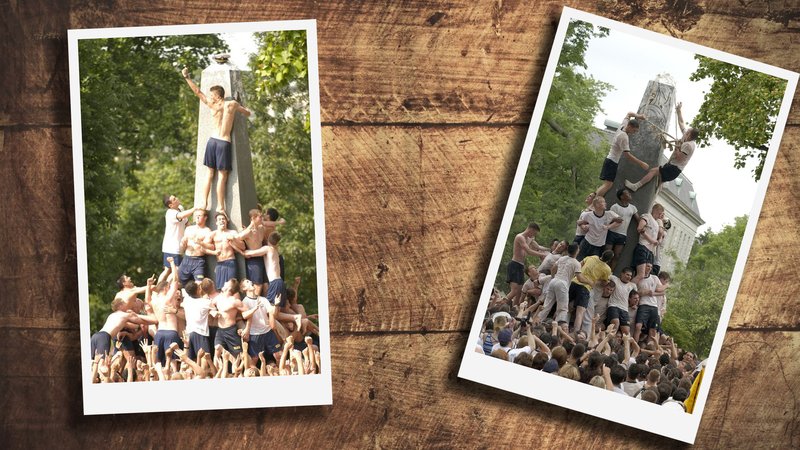
US Naval Academy plebes participate in the iconic Herndon Monument Climb since 1940. Wikimedia photos. Composite by Coffee or Die Magazine.
Each year since the 1940s, during the Naval Academy’s commissioning week, plebes have endured a zany ritual known as the Herndon Monument Climb. The tradition as it exists today involves hundreds of future US naval officers employing the teamwork lessons learned during their first year at the academy to replace the “Dixie cup” cap perched atop a 21-foot-tall, vegetable-shortening-covered obelisk — the Herndon Monument, named in honor of Cmdr. William Lewis Herndon — with the cap typically worn by upperclassmen. The changing of the cap marks the official end to the plebe year.
Beginning in 1962, individual plebe classes have recorded the time it took them to complete the task. The 1962 class built a human pyramid to reach the top of the obelisk and finished in 12 minutes. The class of 1972 achieved the fastest time to date: 1 minute and 30 seconds. However, some alumni may argue that the record is invalid because the 200 pounds of vegetable shortening usually added to the concrete slab were absent that day. The slowest time apparently belongs to the class of 1998 — though, as with the class of 1972, the circumstances were unusual. In this case, the Dixie cup cap was glued and taped at the top, resulting in the remarkably slow time of 4 hours and 5 minutes.
Steel Beach Picnic Day
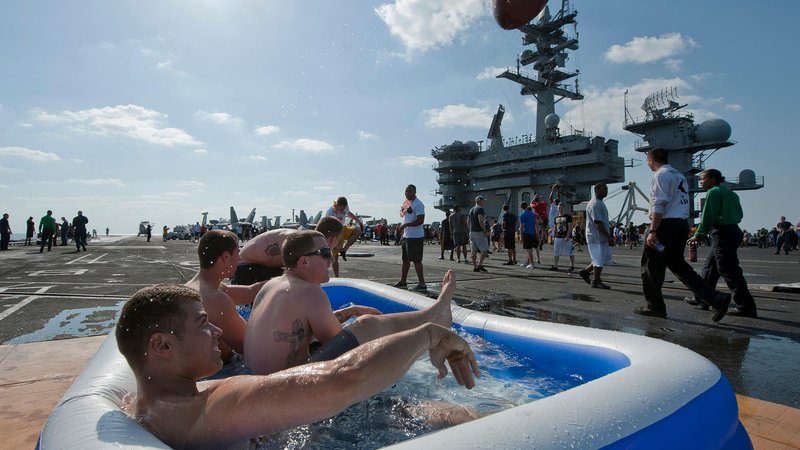
US Navy sailors splashing in a small pool during Steel Beach Picnic Day in 2017. Photo courtesy of the US Navy.
For decades, the Steel Beach Picnic Day tradition has provided sailors at sea with a well-deserved break from the daily grind in the form of a Navy-style barbecue. Held on the decks of aircraft carriers, destroyers, and even submarines, the festivities include the sorts of fun summertime activities that people back home usually enjoy in backyards or at the beach. Depending on the ship, the scene can look like a giant party. On aircraft carriers and destroyers, it often entails loud music playing, a grill master cooking up steaks, hamburgers, and hot dogs, and an assortment of recreational activities, such as volleyball, two-hand touch football, and even skeet shooting. On submarines, sailors might spend the day hitting golf balls off the deck, participating in diving contests, or fishing in lawn chairs.
The Court of King Neptune
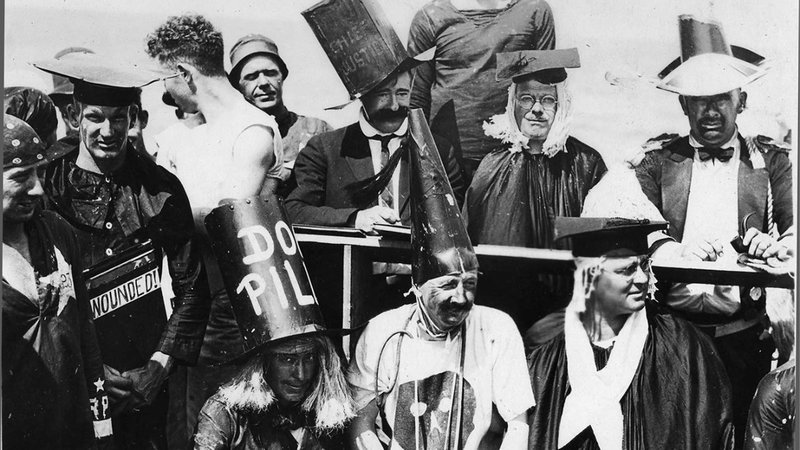
One of several instances of US Navy sailors in disguise as Pollywogs and Shellbacks during the iconic line-crossing ceremonies held over the years. Photo courtesy of the US Naval History and Heritage Command.
Line-crossing ceremonies to mark passing the equator are a rich tradition in the US Navy and can be a somewhat shocking experience for the uninitiated. According to the Naval History and Heritage Command, line-crossing ceremonies throughout history have involved rituals intended to test the fortitude of new sailors on their first open sea cruise. In recent years, weird costumes have become a common feature of the two-day ceremonies ... because, why not?
This is how it usually goes: Newbies, otherwise known as Pollywogs, Slimy Pollywogs, or Slimy Wogs, must undergo a rite of passage under the careful observation of the Court of Neptune. King Neptune — typically a chief dressed head to toe in a robe with a long white beard, crown, and trident to look the part — and his royal court of disguised Shellbacks, or veteran line-crossing sailors, mandate a series of trials that the Pollywogs must endure. These tasks, an assortment of pranks, gags, and strange physical challenges, are generally embarrassing. For example, at one ceremony on board the USS West Virginia in October 1919, an unlucky Pollywog sat in a catapult before being flung into a dunk tank as the Shellbacks watched and cheered. When the events end, the Pollywogs receive a certificate declaring their acceptance into the exclusive club of line-crossers.
Fleet Week
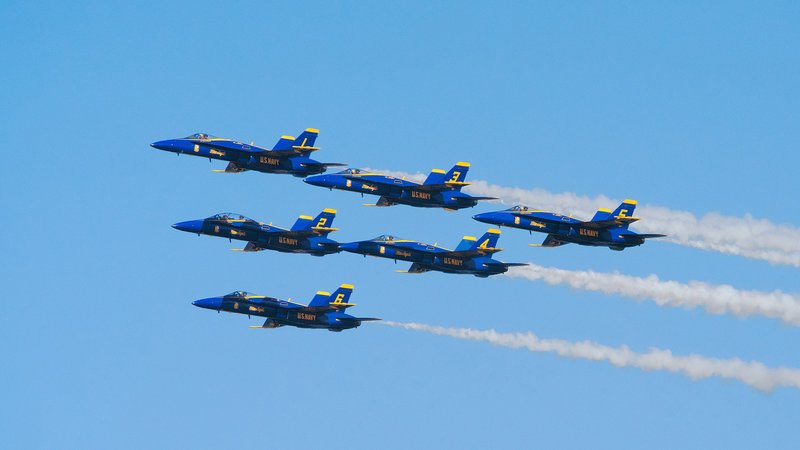
Blue Angels performing at Fleet Week San Francisco in 2016. Wikimedia Commons photo.
Fleet Week is probably the best-known tradition in the US Navy. For those unaware of the US Navy ritual — which also sometimes includes the Coast Guard and the Marine Corps — Fleet Week begins with military vessels docking at various major cities around the country for events and celebrations honoring the US sea services. The most famous Fleet Week is the one that takes place in New York City and is typically scheduled around Memorial Day weekend. Although Fleet Week was first considered official in 1988, US naval vessels have ported at New York City for celebrations since the end of the Spanish-American War in 1898.
Ice Cream
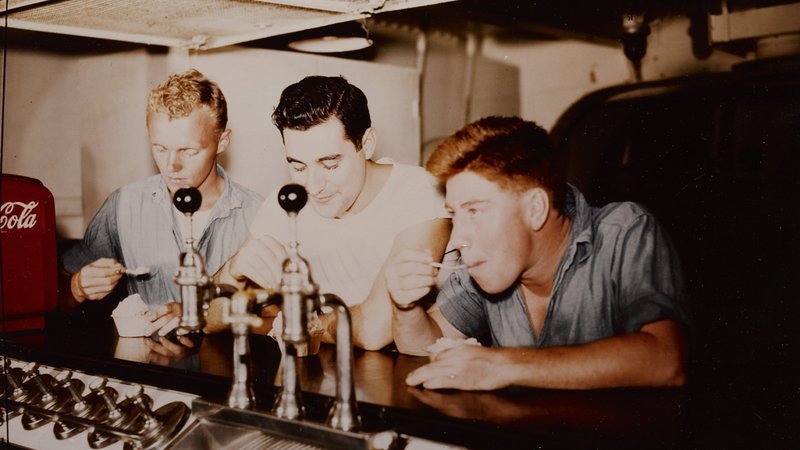
Sailors aboard a US Navy cruiser in 1945 enjoying delicious spoonfuls of ice cream. Wikimedia Commons photo.
Since alcohol was outlawed in the Navy in 1914, ice cream has become the American seafarer's go-to replacement for ice-cold suds. During World War II, the Navy went above and beyond to serve its sailors frozen treats. It even built a $1 million ice cream barge that made 10 gallons of ice cream every seven minutes — or approximately 500 gallons every shift. WWII crews serving on submarines, destroyers, and other naval vessels who rescued downed pilots were rewarded with ice cream.
One sailor named Tom Kocurko, who served on board a destroyer during the war, remembers receiving 10 gallons of ice cream per pilot recovered. More recently, during the Global War on Terror, Chris Fettes, who served as a Navy SEAL, relied on making ice cream to boost morale among his comrades in Iraq and Afghanistan. Fettes continues to make and sell ice cream at Be Free Craft Ice Cream in Virginia Beach.
Read Next: Salty Dogs: The Long and Proud Tradition of Tattoos in the Marine Corps

Coffee or Die is Black Rifle Coffee Company’s online lifestyle magazine. Launched in June 2018, the magazine covers a variety of topics that generally focus on the people, places, or things that are interesting, entertaining, or informative to America’s coffee drinkers — often going to dangerous or austere locations to report those stories.
BRCC and Bad Moon Print Press team up for an exclusive, limited-edition T-shirt design!
BRCC partners with Team Room Design for an exclusive T-shirt release!
Thirty Seconds Out has partnered with BRCC for an exclusive shirt design invoking the God of Winter.
Lucas O'Hara of Grizzly Forge has teamed up with BRCC for a badass, exclusive Shirt Club T-shirt design featuring his most popular knife and tiomahawk.
Coffee or Die sits down with one of the graphic designers behind Black Rifle Coffee's signature look and vibe.
Biden will award the Medal of Honor to a Vietnam War Army helicopter pilot who risked his life to save a reconnaissance team from almost certain death.
Ever wonder how much Jack Mandaville would f*ck sh*t up if he went back in time? The American Revolution didn't even see him coming.
A nearly 200-year-old West Point time capsule that at first appeared to yield little more than dust contains hidden treasure, the US Military Academy said.












